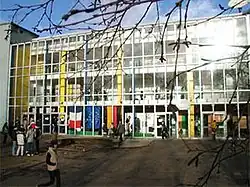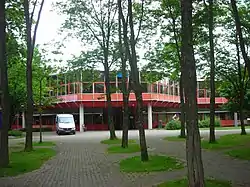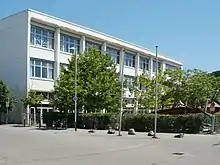Deutsch-Französisches Gymnasium
There are five French-German secondary schools known in German as Deutsch-Französisches Gymnasium (DFG) and in French as lycée franco-allemand (LFA). DFG/LFAs are highly selective schools of excellence.[1][2] Their teachers are paid by the French and German states, and tuition is free of charge.[3][4]
The first DFG/LFA was established in Saarbrücken in 1961 as a cooperation between a French and a German school. In 1972, an agreement signed between France and West Germany formalised the DFG/LFA as a unified school form and introduced the French-German Baccalaureate.[5][6] This agreement was last complemented by the French-German Schwerin Agreement of 2002.[7][8]
The following DFG/LFAs are in operation, two in France:
- DFG / LFA Buc (opened in 1975), and
- DFG / LFA Strasbourg (2021),
and three in Germany:
- DFG / LFA Saarbrücken (1961),
- DFG / LFA Freiburg (1972), and
- DFG / LFA Hamburg (2020).
Nomenclature
In German, the DFG/LFA school form is called Gymnasium, like the German secondary school type (years 5 to 12). In French, it is named lycée, after the French school form (years 10 to 12), although the schools also include collège (years 6 to 9; see education in France).[1]
In English, one academic study called the school form "French-German School", and its final examinations "French-German Baccalaureate".[9] Other publications in English called the school form "Franco-German"[10] or "French-German high school".[11]
French-German Baccalaureate

Students at DFG/LFA schools complete their education with the bilingual French-German Baccalaureate (deutsch-französisches Abitur / baccalauréat franco-allemand). The first French-German Baccalaureate exam was sat by students of the DFG Saarbrücken in 1972.[9] The Baccalaureate is recognised by Germany as equivalent to the Abitur, and by France as equivalent to the Baccalauréat, and currently governed by an agreement signed by the two countries in Schwerin in 2002.[7][8]
Students enter school in separate branches. The French-speaking branch takes seven years and starts with year 6 (sixième), whereas the German branch commences in year 5 (5. Klasse) already because German primary school finishes earlier. German speakers complete the French-German Baccalaureate after eight grades, making it an eight-year Abitur (some regular German schools take nine years instead). French-German co-tuition starts in year 6 and increases until year 9 (9. Klasse / troisième).
Years 10 to 12 are taught in equal shares of French and German. For these final years (Oberstufe / second cycle[12]), students are divided into subject-specific branches. They choose between three branches: L (literary sciences), ES (economics and social sciences) and S (maths and natural sciences). The S branch is split into SMP, maths and physics, and SBC, biology and chemistry. [7][8][13] This corresponds to the branch system of the French Baccalauréat géneral prior to the Bac 2021 reform.[14][15] From the first French-German Baccalaureate in 1972 until 2002, there were only L, SBC and SMP branches. The Schwerin Agreement introduced the ES branch in the 2001-2002 academic year.[16]
| Year | French branch | German branch |
|---|---|---|
| 12 | Terminale: French-German Baccalaureate | |
| 11 | 1re (Première) | |
| 10 | 2de (Seconde): Student chooses L, ES, SBC or SMP branch | |
| 9 | 3e: French-German Brevet | 9. Klasse |
| 8 | 4e | 8. Klasse |
| 7 | 5e | 7. Klasse |
| 6 | 6e: Enrolment | 6. Klasse |
| 5 | – | 5. Klasse: Enrolment |
DFG/LFA schools use a grade scale from 1 (worst) to 10 (best), which is different from both the German (6 to 1 and 0 to 15) and French scales (0 to 20, respectively). Furthermore, the final grade of the French-German Baccalaureate is based on a weighting different from both Abitur and Baccalauréat. The final Abitur grade is based on grades from years 10 to 12, while the Baccalauréat grade depends solely on final exam performance. The French-German Baccalaureate makes a compromise. Preliminary grades from years 10 to 12 count for 25 per cent of the final grade, and final exam performance makes up the remaining 75 per cent.[4]
The French-German Baccalaureate is different from and sometimes[18] confused with the AbiBac, a programme offered at regular French and German schools. The AbiBac programme is bilingual to a lesser extent than French-German schools are. It consists of regular Abitur and up to eight periods weekly teaching in French, or regular Baccalauréat with up to eight periods in German.[19][20]
Other diplomas offered at DFG/LFAs
The DFG/LFA Buc also offers the diploma Option Internationale du Baccalauréat (OIB) British track, in its Section Internationale Anglophone.[21][22]
Phase-out of former diplomas
The DFG/LFA Hamburg was an AbiBac school until 2020, and students admitted until the 2019/20 academic year still sit the AbiBac. The school admitted its first students on the French-German Baccalaureate track in 2020/21, and the first students will graduate with the French-German Baccalaureate in 2028.[23][24]
In Strasbourg, the DFG/LFA was previously the German-speaking Section Internationale of the Lycée Vauban, leading to a French Baccalauréat with OIB German. Thus, students who entered prior to the 2020-21 academic year will still graduate with this diploma. They can also switch to the Lycée International des Pontonniers in Strasbourg and do the AbiBac instead.[25] The first Strasbourg students will graduate with the French-German Baccalaureate in 2029.
French-German Brevet
Regular French schools require their students to sit the Brevet diploma in 3e (troisième) (year 9) in order to finish collège. The same applies to DFG/LFA students in the French branch. They take a French-German version of the Brevet.[26]
See also
- European School, a type of school financed by the European Union
- French bi-national high school programmes
References
- Onisep (20 June 2022). "Les lycées franco-allemands accueillent des collégiens". Ministry of National Education (France).
- n-tv. "Auslaufmodell mausert sich zur Eliteschule". n-tv.de (in German). Retrieved 2022-12-31.
- "Un peu d'histoire" (Archive)/"Schulgeschichte" (Archive). DFG / LFA Buc. Retrieved on 28 April 2015.
- "Ganztagsschulen: DFG Saarbrücken: Respekt vor dem Anderen als Normalität". www.ganztagsschulen.org. Retrieved 2021-05-15.
- "Schulgeschichte". Deutsch-Französisches Gymnasium Saarbrücken (in German). Archived from the original on 2016-08-01. Retrieved 2021-06-16.
- "Bundesgesetzblatt". www.bgbl.de. Retrieved 2021-06-16.
- "Décret n° 2006-713 du 19 juin 2006 portant publication de la convention entre le Gouvernement de la République française et le Gouvernement de la République fédérale d'Allemagne relative aux lycées franco-allemands et au baccalauréat franco-allemand, signée à Schwerin le 30 juillet 2002 (1)". www.legifrance.gouv.fr. Archived from the original on 2021-06-10. Retrieved 2021-06-10.
- "Gesetz zu dem Abkommen vom 30. Juli 2002 zwischen der Regierung der Bundesrepublik Deutschland und der Regierung der Französischen Republik über die deutsch-französischen Gymnasien und das deutsch-französische Abitur". Bundesgesetzblatt. Archived from the original on 2021-06-10. Retrieved 2021-06-10.
- Dervin, Fred (2013). Linguistics for intercultural education. Anthony J. Liddicoat. Amsterdam/Philadelphia: John Benjamins Publishing Company. pp. 175–196. ISBN 978-90-272-7235-5. OCLC 836403381.
- "The Franco-German high school in Buc (78) is getting a new look!". Eiffage.com. 2020-02-05. Retrieved 2021-10-17.
- "Partnerschulnetz". www.partnerschulnetz.de. Archived from the original on 2021-10-17. Retrieved 2021-10-17.
- "Structure scolaire". DFG/LFA Freiburg. Archived from the original on 2015-12-01.
- "Projet de loi Baccalauréat et lycées franco-allemands". www.senat.fr. Retrieved 2021-06-10.
- "AEFE | Choisir son bac". www.aefe.fr. Retrieved 2023-02-06.
- "Les équivalences entre les BAC S, BAC ES, BAC L et les spécialités" (in French). Retrieved 2023-02-06.
- "Projet de loi Baccalauréat et lycées franco-allemands". www.senat.fr. Retrieved 2023-02-06.
- "Präsentation für Grundschuleltern" (PDF). Deutsch-Französisches Gymnasium Saarbrücken. 2020. Archived (PDF) from the original on 2021-10-30.
- Maillasson, Hélène (2021-01-27). "Abi-bac bald im Elsass möglich: Straßburg bekommt deutsch-französisches Gymnasium". Saarbrücker Zeitung (in German). Retrieved 2021-06-10.
- "Deutsch-französische Abiturabschlüsse". Deutsch-Französische Hochschule (in German).
- dfg. "Was ist der Unterschied zu AbiBac-Schulen? – Deutsch-Französisches Gymnasium" (in German). Retrieved 2021-06-10.
- "Section Internationale Anglophone (SIA) -Lycée Franco-Allemand". www.lfa-buc.fr. Retrieved 2022-12-30.
- "High School – PSAB Parents de la Section Anglophone de Buc". Retrieved 2022-12-30.
- "FAQ – Deutsch-Französisches Gymnasium". dfg-lfa.hamburg.de. Retrieved 2022-12-30.
- DFG Hamburg. "DFG | INFORMATIONEN ZUM ERLANGEN DER ALLGEMEINEN HOCHSCHULREIFE IM ABIBAC" (PDF).
- "SI Allemande – Collège international et lycée franco-allemand Vauban Strasbourg". www.college-vauban-strasbourg.fr. Retrieved 2022-12-30.
- "Diplôme national du brevet". Ministère de l'Education Nationale de la Jeunesse et des Sports (in French). Retrieved 2021-06-10.
External links
- Governing French-German agreements
- Paris 1972: Abkommen zwischen der Regierung der Bundesrepublik Deutschland und der Regierung der Französischen Republik über die Errichtung deutsch-französischer Gymnasien und die Schaffung des deutsch-französischen Abiturs sowie die Bedingungen für die Zuerkennung des Abiturzeugnisses (at German Bundesgesetzblatt)
- Hamburg 1977: Vereinbarung über die Rechtsstellung der deutsch-französischen Gymnasien (at German Bundesgesetzblatt)
- Schwerin Agreement 2002 (at French Legifrance) (at German Bundesgesetzblatt)
- Conversion formula: French-German Baccalaureate marks (pass from 6-10) to German KMK Abitur points (pass from 300 to 900) (at KMK)
- Conversion table: French-German marks (1-10) to French marks (0-20) (at DFG/LFA Buc)
 Media related to French-German high schools at Wikimedia Commons
Media related to French-German high schools at Wikimedia Commons


.jpg.webp)

